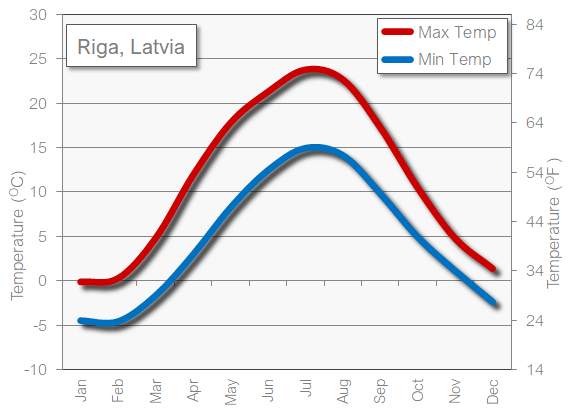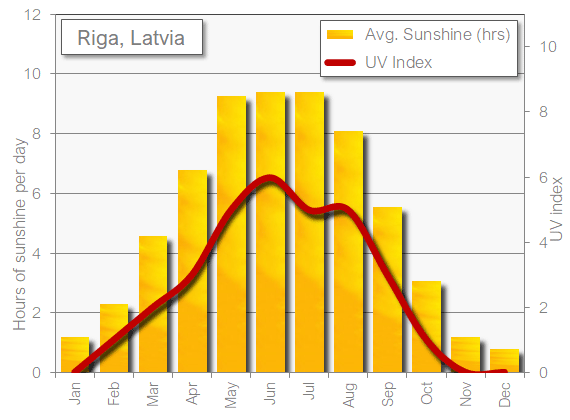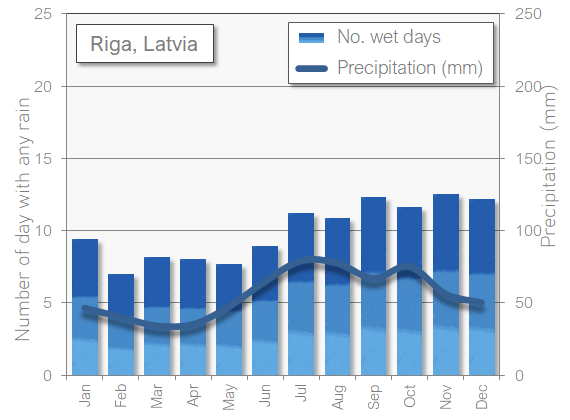Riga, Latvia in November - The weather and is it a good time of year to visit?
Riga, Latvia's captivating capital, blends medieval charm with Art Nouveau elegance along the banks of the Daugava River. This Baltic gem offers visitors a rich tapestry of history, from its UNESCO-listed Old Town with cobblestone streets and Gothic spires to its vibrant Central Market housed in former Zeppelin hangars. The city's cultural scene thrives year-round with world-class opera, innovative museums, and a burgeoning culinary landscape that celebrates both traditional Latvian fare and contemporary Nordic cuisine.
November marks the transition into Riga's winter season, bringing a quieter, more contemplative atmosphere to the city. Whilst it's certainly not the most popular time to visit due to chilly temperatures and limited daylight, November offers unique advantages for travellers seeking authentic experiences without summer crowds. The month's crisp air and potential early snowfall create a particularly atmospheric backdrop for exploring historic streets, and you'll find hotels and restaurants offering excellent value compared to peak season prices.
Overview of Riga's Climate in November
November in Riga represents late autumn sliding into early winter, characterised by increasingly cold temperatures and diminishing daylight hours. The month typically begins with the last vestiges of autumn, with bare trees and fallen leaves carpeting parks and pavements, before transitioning towards winter's first hints of frost and snow. The Baltic Sea's proximity influences the climate, creating a damp cold that can feel more penetrating than the temperature alone might suggest.
Cloud cover dominates the skies, and whilst dramatic weather events are rare, the month carries an unmistakable sense of winter's approach, with locals already bundled in warm coats and the city's heating systems working at full capacity.

November temperatures in Riga hover in distinctly chilly territory, with average daytime highs reaching only about 3-5°C (37-41°F), whilst nighttime temperatures regularly drop to around -1 to 1°C (30-34°F). Early November might still see occasional mild days reaching 7-8°C (45-46°F), but by month's end, freezing temperatures become increasingly common, and daytime highs might struggle to climb above 2°C (36°F).
The cold in Riga carries a particular Baltic character—it's a damp, penetrating chill that seems to seep through layers of clothing, especially when the wind picks up from the sea. You'll definitely need proper winter clothing throughout your stay, as even the warmest November days would be considered cold by most standards. Indoor heating is excellent throughout the city, so museums, restaurants, and hotels provide welcome respite from the outdoor chill.

One of November's most striking characteristics in Riga is the rapidly diminishing daylight, with the month beginning with approximately 9 hours of daylight and ending with just over 7 hours. Sunrise occurs around 7:30 AM at the start of November, shifting to nearly 8:30 AM by month's end, whilst sunset advances from approximately 4:45 PM to as early as 3:50 PM by late November.
Sunshine itself proves rather elusive during November, with Riga averaging only about 30-35 hours of sunshine throughout the entire month—roughly one hour per day. Heavy cloud cover dominates most days, creating a grey, overcast atmosphere that defines the month's character. When the sun does appear, it sits low on the horizon, casting long shadows and creating beautiful, albeit brief, golden light perfect for photography. Clear days are treasured rarities that locals and visitors alike savour.

November ranks amongst Riga's wetter months, with average precipitation of about 60-70mm spread across 18-20 days. Rain dominates early November, often arriving as persistent drizzle or light showers rather than heavy downpours. As temperatures drop, late November might see this precipitation transition to sleet or light snow, though significant snow accumulation remains relatively uncommon. The humidity levels stay high throughout the month, typically ranging from 80-90%, contributing to that penetrating Baltic cold that makes the temperature feel even chillier than the thermometer suggests.

The Baltic Sea near Riga in November registers decidedly uninviting temperatures of approximately 6-8°C (43-46°F), making it suitable only for the most hardy cold-water swimmers or those equipped with proper wetsuits. The grey, choppy waters reflect the season's sombre mood, and beach activities are essentially non-existent save for contemplative walks along the shore at nearby Jurmala.
Packing Tips and Recommendations for Riga
Your November wardrobe for Riga should prioritise warmth and water resistance over style, though the city's fashionable residents prove you needn't sacrifice aesthetics entirely. Essential items include a warm, waterproof winter coat, ideally one that extends below your hips for extra protection against the cold. Layer underneath with thermal undergarments, wool jumpers, and long-sleeved shirts that you can adjust based on indoor and outdoor temperatures. Don't forget a warm hat that covers your ears, a cosy scarf, and insulated, waterproof gloves—these accessories make an enormous difference when exploring the outdoor markets or walking the Old Town's cobblestone streets.
The best months to visit Riga
The optimal time to visit Riga falls between May and September, when the city truly comes alive under extended daylight and pleasant temperatures. June and July represent the absolute peak, with white nights creating an almost magical atmosphere where daylight extends until nearly 11 PM, perfect for evening strolls along the Daugava River or outdoor dining in the Old Town's charming squares. These summer months see temperatures reaching comfortable 20-23°C (68-73°F), ideal for exploring both the city's outdoor attractions and nearby beaches at Jurmala. The parks burst with greenery, outdoor cafes overflow with locals and tourists alike, and the city hosts numerous festivals celebrating everything from music to traditional crafts.
The worst months to visit Riga
The most challenging period for visiting Riga stretches from November through March, with January and February proving particularly difficult for those unaccustomed to harsh Baltic winters. January temperatures plummet to average highs of -2°C (28°F) and lows reaching -7°C (19°F) or colder, whilst daylight shrinks to a mere 6-7 hours. The combination of extreme cold, minimal sunshine, and icy conditions can make sightseeing genuinely uncomfortable, if not outright miserable, especially for visitors from warmer climates. Many outdoor attractions close or operate reduced hours, and the grey, frozen landscape can feel oppressively bleak during extended stays.
The Best Activities and Sights of Riga in November
Explore the House of the Blackheads and Old Town Squares: November's quieter streets allow for unhurried exploration of Riga's UNESCO World Heritage Old Town. The magnificent House of the Blackheads, rebuilt to its original 14th-century glory, offers fascinating exhibits about Riga's merchant history whilst providing shelter from the cold. The surrounding Town Hall Square takes on a special atmosphere as Christmas market preparations begin in late November, with wooden stalls appearing and lights being strung between buildings.
Visit the Art Nouveau District with Indoor Museum Stops: Riga boasts Europe's highest concentration of Art Nouveau architecture, and November's soft, diffused light actually enhances photography of these ornate facades. Combine outdoor admiration with warming visits to the Riga Art Nouveau Museum on Alberta Street, where you can explore a perfectly preserved period apartment and learn about this architectural movement's significance to the city's identity.
Experience the Central Market's Seasonal Offerings: Housed in massive former Zeppelin hangars, Riga Central Market provides an authentic glimpse into local life whilst offering complete protection from November's weather. Sample seasonal specialties like smoked fish, pickled vegetables, and hearty rye breads, or warm up with hot soup from one of the food vendors. The market's vast indoor spaces mean you can spend hours browsing local products, from amber jewellery to woollen goods perfect for the cold weather.
Indulge in Riga's Thermal Spa Culture: November's chill makes it the perfect time to discover Latvia's spa traditions. ESPA Riga at the Radisson Blu Hotel offers luxurious treatments with panoramic city views, whilst more budget-friendly options like Lielupe Hotel SPA in nearby Jurmala provide access to saunas, thermal pools, and therapeutic treatments. Many spas offer day packages that include multiple treatments, lunch, and pool access—ideal for a full day of warming relaxation.
Tour the KGB Building and Museum: The Corner House, former headquarters of the Soviet KGB, offers chilling insights into Latvia's occupation period. The guided tours through interrogation rooms and prison cells prove particularly atmospheric during November's grey days, and the indoor nature of the attraction makes it perfect for cold weather. The knowledgeable guides provide personal stories that bring this difficult history to life in ways that summer's crowds might dilute.
Attend Performances at the Latvian National Opera: November marks the heart of the opera and ballet season, with world-class performances in one of Europe's most beautiful opera houses. The neo-classical building provides a warm, elegant escape from the cold, and ticket prices remain remarkably affordable compared to other European capitals. Even if opera isn't typically your interest, the building's architecture and atmosphere make attending a performance memorable.
Take a Day Trip to Sigulda and Turaida Castle: Just an hour from Riga, Sigulda offers stunning autumn landscapes that remain beautiful even in November's later stages. Turaida Castle's red brick tower provides panoramic views over the Gauja River valley, whilst the museum complex includes indoor exhibitions perfect for cold weather. If you're lucky enough to catch early snow, the scene becomes particularly magical, and the nearby cable car across the valley operates year-round, offering spectacular views regardless of weather.
Discover Riga's Soviet Heritage in Āgenskalns: This left-bank district showcases wonderful wooden architecture and the massive Academy of Sciences building, Stalin's "birthday cake" skyscraper offering panoramic city views from its observation deck. The neighbourhood's authentic local cafes and restaurants provide perfect warming stops between sights, and November's lack of tourists means you'll experience genuine local atmosphere. The indoor Āgenskalns Market, smaller and more intimate than Central Market, offers another glimpse into everyday Rigan life.
November in Riga certainly challenges visitors with its cold temperatures and limited daylight, but for those properly prepared and seeking authentic experiences beyond the tourist season, the month offers unique rewards. The city's cultural richness shines through regardless of weather, and the absence of crowds combined with lower prices can make for a surprisingly satisfying Baltic adventure.